Keeping laying hens at home in winter
Laying hens, pleasing to the eye of the owner and beneficial, have always been considered unpretentious and profitable pets of a private backyard. And remembering how many pleasant minutes the collection of tasty, fresh eggs from the nests brings, there is no reason to doubt - laying hens are simply necessary in the household.
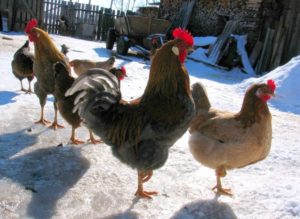
Keeping domestic layers for long, harsh winters is much more troublesome and differs significantly from the care and cost of poultry in summer. True, the creation of the necessary conditions is not a difficult task and does not require large material costs. Having properly prepared the place of detention for the winter period, having prepared nutritious and fortified feed, you can not only save the livestock, but also get useful homemade eggs all winter.
Content
- 1 Keeping laying hens in the winter at home - general recommendations and advice
- 2 Features of the diet and rules for feeding laying hens in winter
- 3 Preparing the chicken coop for winter
- 4 How to keep chickens in winter in the absence of a warm room or without heating
- 5 Walking hens in winter
- 6 Factors affecting egg production in chickens in winter
Keeping laying hens in the winter at home - general recommendations and advice
Preparations for wintering hens should begin long before the onset of the first frost. First of all, when you grab a chicken coop or another place planned to accommodate feathered pets, you need to try to create comfortable conditions so that the coming bad weather and cold affect the way of life of the layers as little as possible. When preparing the chicken coop for the winter, you should pay attention to the livestock, leaving the necessary minimum of healthy, well-laying birds for the winter.
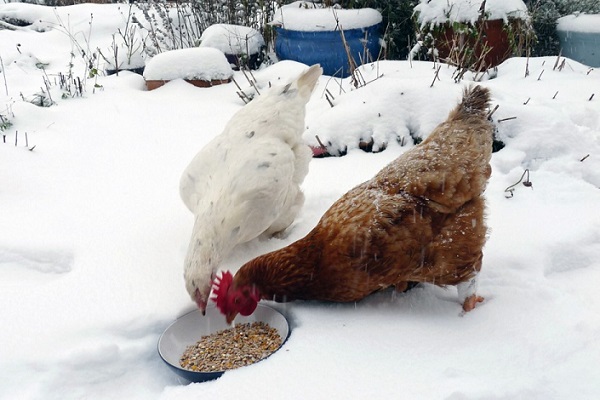
Laying hens should be especially well fed during the cold season. High-quality and varied feed will help the bird to endure the winter more easily, will help to maintain active egg production.
Features of the diet and rules for feeding laying hens in winter
The summer diet of poultry is very rich and varied. The abundance of plant and protein foods, vegetables and fruits, being a good feeding, fully meet the needs of the chicken for nutrients and minerals, vitamins. In late autumn, this wealth begins to dwindle, and the poultry house is required to diversify and saturate the feed with everything necessary. Let's talk in more detail about the diet of laying hens in winter.
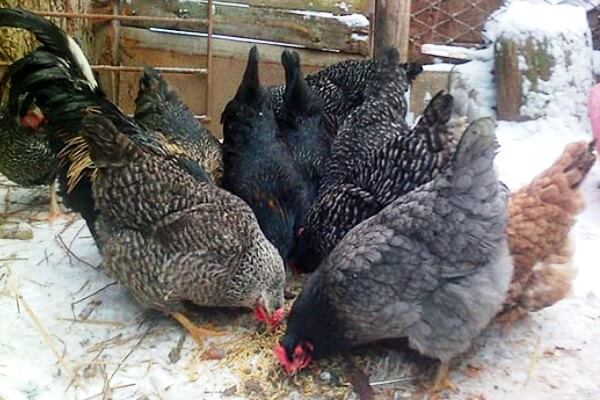
What is the best way to feed laying hens in winter?
Practical tips for feeding laying hens in winter:
- Increase the number of feedings, bringing the minimum amount to 3 times a day. At low temperatures, the chicken's body needs heating and spends much more energy on this, the consumption and intake of which should be carried out evenly throughout the day. Succulent feed and mash should be given in the morning and at lunchtime; dry feed should be used in the evening. Coarse food, digesting longer, provides the bird with the necessary energy at night.
- Diversify the diet as much as possible, introduce mash, cereals, vegetables and melons. Combine different feeds.
- Try to add to the diet more fresh, green feed. Provide hens with hay harvested in summer, preferably deciduous plants. It is advisable to hang hay above the floor. It is useful to give dried nettles, branches of conifers.
- Supplement food sprouted oats, wheat. Sunflower seeds and cake are very useful.
- A good feeding is fish and bone meal, mineral and vitamin supplements, in a rich assortment offered by manufacturers. Fish oil, in small amounts added to roughage, has a good effect on the body of a bird.
- Poultry feeding significantly increases egg production proteins of vegetable origin. Reverse, whey, cottage cheese are used.
- The bird's body must be fully saturated with calcium and foods with its rich content. In the chicken coop, a container with sand, small pebbles, shell rock is required. It is necessary to give crushed eggshells, chalk.
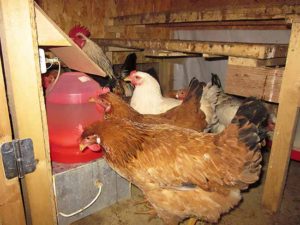
- Drinkers poultry must be kept clean, they must always have clean and fresh water. Chickens are prone to colds, so they need to drink water at room temperature. The poultry house needs to control this issue by adding warm water to the drinker in winter. You can even make a special winter drinker for chickens.
When choosing a balanced diet and setting the daily amount of food, it must be remembered that excess nutrition has a bad effect on the egg production of layers, including in winter. They gain extra weight, lose activity, and run worse.
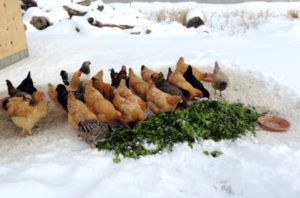
One bird consumes about 150 grams of food per day. Based on this, the daily volume required for all livestock is determined. The correct indicator is considered if there is almost no food left in the feeders by the next feeding.
Each house sets the feeding schedule and teaches the poultry. Usually the first visit to the hen house takes place from 6 to 8 in the morning. At lunchtime, chickens are fed at 1 pm, at night between 5 and 6 pm.In the morning and for lunch, they give mash, at night, grain of cereals. Each time, be sure to top up with fresh, warm water. Fresh hay is added. Remove low-quality food debris.
Giving hens products from the home table need to rememberthat sweet pastry, black bread, meat are not recommended. Do not give beets in large quantities. Potatoes in the diet of chickens should only be boiled.
Video: how to feed chickens in winter
Note! Many poultry houses grow fodder root crops and vegetables specifically for feeding laying hens in the winter.
Preparing the chicken coop for winter
Preparation for winter must be carried out long before the onset of the first frost. You need to start with a chicken coop or other place planned to accommodate feathered pets.
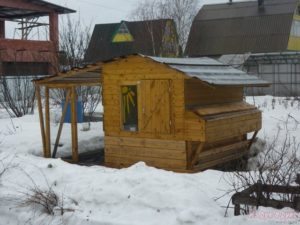
When preparing a chicken coop for the winter keeping of domestic layers, you must:
- Conduct general cleaning places of detention, disinfect the room as efficiently as possible.
- Verify ventilation work.
- Conduct overhaul of chicken coop equipment, perches and nests.
- Qualitatively insulate the room, excluding the slightest drafts and moisture getting into the chicken coop.
- Prepare quality lightingrequired by hens on a short winter day.
Video: lighting in the chicken coop in winter
The easiest way is to prepare a capital chicken coop for winter. If the bird is planned to be kept in another place, it is necessary to create appropriate conditions for its keeping.
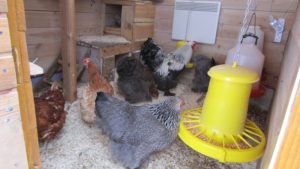
Thorough warming of the house brings great positive results. For the health of the entire flock of layers, it is very important to eliminate all drafts, as well as the possibility of moisture entering the room.
Video: heating a chicken coop in winter
How to insulate a chicken coop for the winter?
General requirements for a hen house intended for winter keeping hens:
- Comfortable temperature... The optimum temperature for keeping hens in a hen house should be between + 10 ... + 18 ° C. A lower or higher temperature begins to significantly reduce the egg production of birds. A thermometer should be installed in a convenient place for monitoring. If there is a fear of a drop in frost temperatures below +10 ° C, you need to think about a stationary heating source. When choosing a heating system, special attention must be paid to the safety of the layers.
- Optimum air humidity. The relative humidity in the house should be 70%.
- Correctly placed equipment. Perches and nests should be at least 60 cm above the floor. Drinkers and feeders should be approached comfortably.
- Effective lighting... The hen house should be provided with high-quality lighting that artificially prolongs the short winter day. Daylight hours for laying hens in winter should be at least 13 hours. Artificial lighting is applied early in the morning and at sunset, extending the daylight hours as needed. It is best to illuminate the chicken coop with fluorescent lamps. It is best to turn the light on and off at the same time, developing a regime that is beneficial for laying hens.
- Good ventilation. The room must have effective ventilation.
- High quality bedding. The floor in the hen house in several layers should be sent out with litter. Hay or straw, sawdust, chopped reeds, dry moss are used as material. Wet litter should be removed immediately and replaced with dry one. Once every few days, it must be agitated, turned over. A high-quality bedding not only maintains the hygiene of the room, but is also an additional source of heat.
- Mandatory ash drawer, flutters.
The installation of automatic relays, turning on the light, automating ventilation and heating, greatly simplifies the maintenance of the chicken coop in winter.
Video: warm chicken coop in winter
How to keep chickens in winter in the absence of a warm room or without heating
If there is no warm, stationary chicken coop to keep the hens, you should not despair. Quite simply and inexpensively for poultry, almost any existing room can be adapted. Chicken-birds are picky and tolerate winter well even in poorly adapted conditions. Moreover, in prepared and equipped places they winter with pleasure, constantly delighting the owner with eggs.
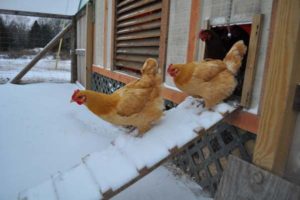
Whatever room is converted, the main requirement for it remains the same - to create comfortable conditions for feathered pets.
Taking into account the prescriptions that are mandatory for a stationary chicken coop, everything necessary must be completed as much as possible.
Is it possible to keep laying hens in the garage
Many poultry houses have long and quite effectively used the garage for keeping layers in winter. Of course, the place originally not adapted for the life of feathered pets will have to be re-equipped, creating acceptable conditions. The concrete floor of the garage is detrimental to bird health. Therefore, it is advisable to cover it with wooden flooring and fill it with bedding. Usually, poor ventilation in garages will also need to be remodeled to accommodate the new tenants. Create the desired humidity, make lighting. Re-equipping a garage for a chicken coop does not take much time and effort, bringing benefit and pleasure to your wet nurses.
Video: keeping chickens in the garage in winter
Wintering hens in a polycarbonate greenhouse
In recent years, many poultry houses have found an interesting solution - wintering of laying hens in greenhouses. The use of premises that are empty during the winter is becoming more and more popular and is considered a very effective and expedient occupation. In order for the wintering of the bird to be successful, it is required to create favorable conditions by carrying out work on the arrangement of the greenhouse.
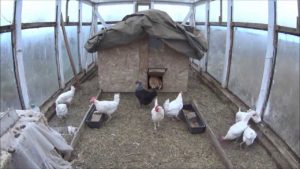
When preparing a greenhouse for placement of laying hens for the winter, it is necessary:
- clean the room, remove excess land;
- eliminate drafts;
- make ventilation;
- carry out artificial lighting;
- sprinkle the floor with a litter;
- install the necessary equipment, perches.
The most important issue that the poultry house will have to solve is maintaining a comfortable temperature regime. Even in the most severe frost, the temperature in the greenhouse should not drop below 0 ° C, below the chickens simply cannot withstand. Therefore, additional heating is indispensable.
Video: wintering chickens in a greenhouse in winter
Important! In winter, a greenhouse adapted for a chicken coop can be covered with a layer of snow from the sides. This will significantly preserve the internal heat.
Video: how chickens winter in a polycarbonate greenhouse
Walking hens in winter
In winter, letting a bird out of the hen house is not only possible, but also necessary... The walk should be arranged on a sunny, not frosty day. It is not recommended to let laying hens outside in winter when the frost is more than minus 10 ° C, the bird can freeze its paws, catch a cold. The total time spent on the street should be no more than two hours. The walking area should be lined with hay, and the old bedding from the chicken coop will do. The best time for walking chickens in winter is a thaw and not frosty, sunny days.
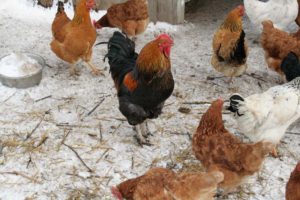
Factors affecting egg production in chickens in winter
Winter leads to a decrease in natural biorhythms in chickens. The winter temperature decrease and a decrease in daylight hours also affect egg production. Vitamin deficiency, lack of plant and protein foods have a negative effect. Proper care, no stress, balanced nutrition helps to significantly extend the period of egg production and get fresh eggs almost all winter.
Video: how to feed chickens in winter so that they lay eggs
Read more about the peculiarities of egg production in chickens in winter in this article.
Every day it becomes easier and more profitable to keep laying hens. New, more productive breeds are being developed, effective, balanced feed and various additives appear. Manufacturers offer automated bird care systems. New building materials make it easier to build chicken coops.As a result, the number of laying hens is increasing. Join us and there will always be fresh homemade eggs on your table.
Video: the correct device for a winter chicken coop

